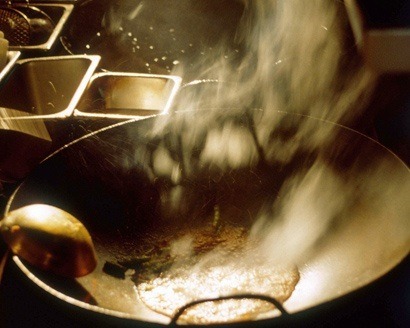How To Season A Wok
What does it mean to season a wok? According to Nathan Myhrvold, Chris Young, and Maxime Bilet, the authors of Modernist Cuisine: The Art and Science of Cooking, it "is the same process that is used to 'season' a new steel or cast-iron frying pan in Western-style cooking," in which "esters form a strong and durable film bound to the metal that repels water and protects the wok from the food." Furthermore, they write, "With proper use and care, the patina becomes thicker and more durable over time. It's the patina that makes a wok or a skillet nonstick."
How is this patina formed? For a carbon-steel wok, the type commonly found in most home goods stores, the process is simple. First, wash off the factory coating with plenty of soap and hot water using a scrubbing pad or steel wool. Make sure to scrub on the exterior as well. Then, rinse and dry the wok thoroughly. To get rid of any remaining moisture, place the pan over high heat until the water is evaporated. At this point, turn on the kitchen ventilation hood and open some windows.
Continue heating the wok, moving it around in all directions, until the surface of the metal changes color. (Blue is pretty common, so don't worry.) Next, choose an oil with a high smoke point, such as canola, safflower, or corn oil. (Lard also works really well.) You'll need to achieve a temperature of at least 900 degrees Fahrenheit, according to Modernist Cuisine. Add about two teaspoons oil and rotate the pan again to coat all over. The oil will smoke like crazy. Continue heating for 10 to 15 minutes.
Turn off the heat, let the pan cool, and then wash it out with just hot water (no soap). This is the beginning of the process of forming a patina. Over time, "a durable waterproof film made from oxidized fat [will form] that is bound electrochemically to the metal." The wok should be discolored in spots — this is the patina starting to form.
To make sure the patina forms over time and stays on the wok, you'll need to cook with it at least three times a week. Once the patina is formed, it's important to note that in the early stages of a wok's life, you'll need to avoid cooking certain foods and to avoid certain techniques which can erode the patina. Don't cook with acidic foods such as vinegar or tomatoes, and avoid boiling or simmering water, both of which can take away the patina. Most importantly, each time you wash out the wok, use only hot water and a sponge — no soap. With proper use and care, your wok will eventually form a natural, water-repellent barrier that will last for a lifetime.
Will Budiaman is the Recipe Editor at The Daily Meal. Follow him on Twitter @WillBudiaman.
